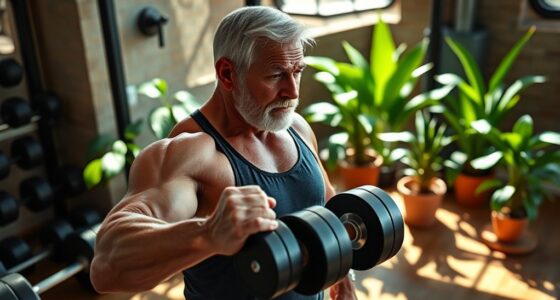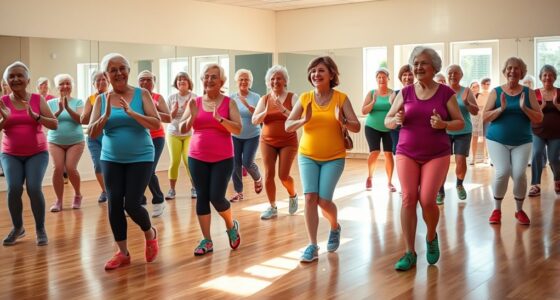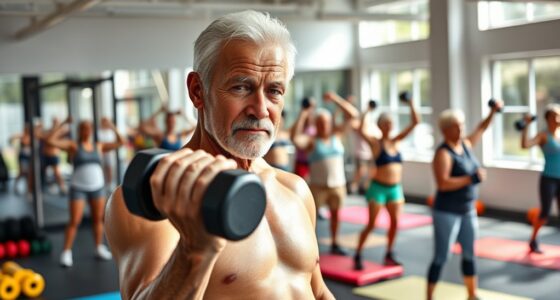In just 15 minutes, you can boost your strength, flexibility, and cardiovascular health. Start with a warm-up like marching in place, then incorporate easy strength exercises like arm curls and overhead raises. Add stretches to enhance flexibility and cool down to aid recovery. Remember to maintain good posture throughout. Engaging in quick workouts not only enhances mood but also builds resilience. Keep going, and you’ll discover more tips for effective workouts tailored just for you!
Key Takeaways
- Quick 15-minute workouts can enhance cardiovascular health, strength, and flexibility, providing benefits similar to longer routines.
- Utilize a sturdy chair and light weights for support and resistance during exercises, ensuring safety and proper form.
- Incorporate exercises like arm curls, side leg raises, and balance training to strengthen muscles and improve stability.
- Begin with a warm-up like marching in place, followed by stretching to prepare muscles and enhance flexibility.
- Cool down after workouts to lower heart rate and promote recovery, ensuring a gradual transition back to rest.
The Importance of Quick Workouts for Seniors

As you age, finding time to exercise can feel challenging, but quick workouts can be a game-changer for your health. Engaging in short, 10 to 20-minute sessions can greatly boost your cardiovascular health, strength, and flexibility without overwhelming you. Research shows that high-intensity quick workouts often provide similar benefits to longer routines, making them perfect for seniors with limited time or energy. A fitness instructor or personal trainer can help you adapt these routines to your abilities, ensuring you still achieve meaningful health improvements. Additionally, regular exercise has been shown to enhance mental clarity and emotional resilience, contributing to overall well-being. Incorporating individualized fitness plans can further tailor workouts to meet specific health needs. Regular physical activity has also been linked to improved heart health, which is crucial for seniors. Plus, these fast workouts can enhance your mood and mental well-being, reducing anxiety and depression. By committing to regular short workouts, you’ll maintain independence and mobility, essential for enjoying daily activities and improving your overall quality of life. Incorporating gentle stretching into your routine can also help alleviate muscle tension and improve flexibility. Furthermore, including whole foods in your post-workout meal can provide essential nutrients for recovery and support your overall health.
Essential Equipment for Your 15 Minute Workout

Quick workouts can be highly effective, but having the right equipment makes a significant difference. For your 15-minute workout, a sturdy chair with arms is essential for support and stability during exercises. Additionally, it’s important to consider your lifestyle and environment when choosing exercises to ensure they fit your needs and capabilities. Regular vacuuming can help maintain a clean workout space, free from dust and allergens that could impact your health.
You’ll also need two equally weighted objects, like dumbbells or water bottles, to enhance your strength training. Incorporating two tennis balls can add a little bit of fun while improving balance and grip strength. Engaging in educational and skill-building toys can also help improve coordination as a part of your fitness routine.
A towel is handy for stretching, especially for shoulder and triceps stretches, helping you achieve a better range of motion. Don’t forget to keep hydration close by with water bottles, encouraging regular breaks to prevent fatigue. Additionally, consider using portable camping toilets for comfort during longer workout sessions outdoors.
This simple equipment guarantees you get the most out of your quick workout!
Warm-Up Routine to Get Started

A good warm-up routine is vital for preparing your body for exercise, especially as a senior. Start by marching in place for a few minutes to raise your heart rate and warm up your muscles.
Next, shift to a step touch movement while incorporating arm movements to loosen your shoulders and warm up your upper body. Incorporating seeds like chia seeds in your diet can help provide energy and support during your fitness routine. These seeds are rich in fiber, which aids digestion and promotes a feeling of fullness, supporting weight management. Additionally, engaging in activities like texting humor can boost your mood and motivation to stay active. Chia seeds are also a great source of omega-3 fatty acids, which can support heart health and reduce inflammation.
For the final phase, try seated quad warm-ups and calf stretches to enhance leg flexibility and improve your balance. Additionally, maintaining good air quality during workouts can significantly influence your overall performance and well-being.
Strength Training: Building Muscle Safely
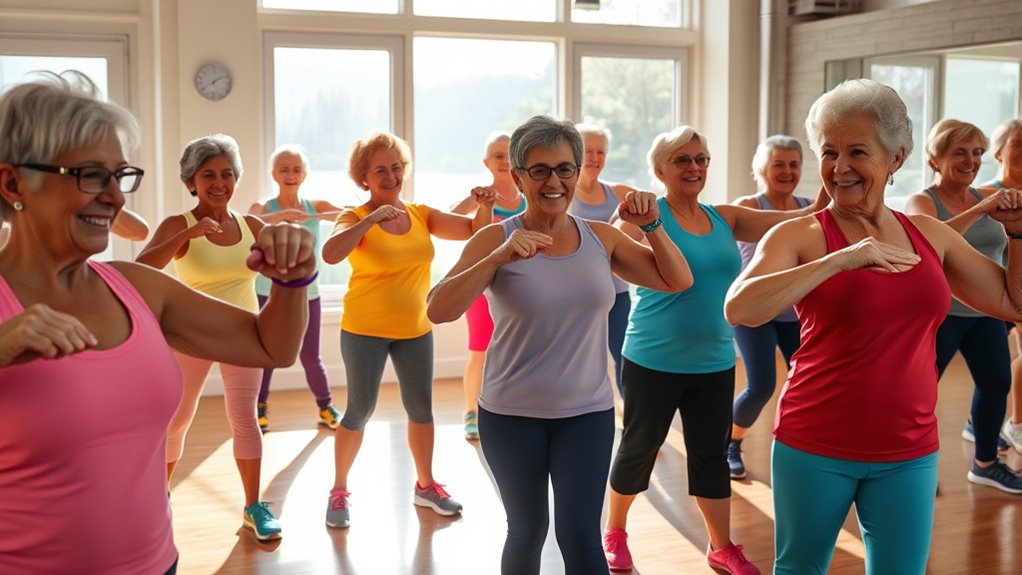
When it comes to strength training, safety and proper form are key to building muscle effectively.
You’ll want to focus on techniques that guarantee you’re exercising safely, like maintaining a stable stance and keeping your movements controlled. Regular preventive care can also help you avoid injuries related to muscle strain and overexertion. Additionally, having a clear understanding of filial responsibility laws can help you ensure that any potential medical expenses from injuries are managed responsibly. In many states, like Georgia, the average duration of divorce proceedings can be 6 to 12 months, emphasizing the importance of managing stress during recovery. Furthermore, incorporating strength training systems can enhance your routine and provide structured support for your fitness goals.
Plus, modifying exercises to fit your individual needs can make a big difference in your training routine. Additionally, understanding the financial implications of injuries related to improper lifting can help you prioritize safety even further.
Safe Exercise Techniques
Here are some key safe exercise techniques to keep in mind:
- Keep your feet shoulder-width apart and elbows tight to your sides during arm curls. Additionally, maintaining a high contrast ratio can help enhance visibility during exercise routines in low light conditions. Regular socialization opportunities with others, even in exercise settings, can improve overall motivation and enjoyment.
- Engage your core muscles consistently, especially during chair stands, to maintain stability and balance.
- Use modified exercises, like chair dips and leg raises, to accommodate your fitness level and any physical limitations.
Listening to your body is essential; take breaks when needed and adjust exercises for comfort. Additionally, consider incorporating essential oils for muscle relief post-workout to soothe any discomfort.
Finally, don’t forget to stretch after your workouts, holding each stretch for 15 to 30 seconds to improve flexibility and relieve muscle tension.
Importance of Proper Form
Proper form plays a significant role in strength training, especially for seniors. Using correct techniques helps prevent injuries and guarantees you’re engaging the right muscles. Here are some essential points to remember:
| Key Aspect | Importance | Tips |
|---|---|---|
| Stance | Enhances stability | Keep feet shoulder-distance apart |
| Elbow Position | Reduces strain | Keep elbows close to your sides |
| Core Engagement | Protects the lower back | Engage core during all exercises |
| Movement Speed | Improves muscle engagement | Use slow, controlled movements |
Modifications for Individual Needs
Modifying exercises to meet individual needs is essential for safe strength training, especially for seniors. By adapting workouts, you can build muscle without risking injury.
Here are some simple modifications to take into account:
- Use a sturdy chair for support during arm curls and chair dips, ensuring stability while you work on strengthening your arms.
- Listen to your body and adjust the intensity; perform fewer repetitions or use lighter weights if you start to feel strained.
- Incorporate seated quad warm-ups and calf stretches to accommodate your flexibility and strength levels comfortably.
Prioritizing proper form and engaging your core will help prevent injuries while maximizing your strength-building effectiveness.
Also, adding balance exercises like side and back leg raises can enhance stability, vital for fall prevention.
Arm Curls: Strengthening Your Upper Body

When doing arm curls, maintaining proper form is essential to avoid injury and maximize benefits.
You should choose a weight that challenges you but allows you to complete ten repetitions with good technique.
Focusing on these aspects will help you strengthen your upper body safely and effectively.
Proper Form Importance
Maintaining the right form during arm curls is essential for preventing injuries and maximizing the benefits of the exercise.
To guarantee you’re getting the most out of your arm curls, focus on the following:
- Stand with your feet shoulder-width apart, keeping your elbows tight to your sides.
- Engage your core and maintain good posture by standing tall throughout the movement.
- Perform controlled movements, avoiding any rushing to enhance muscle activation.
Repetitions and Weight Choice
Choosing the right number of repetitions and the appropriate weight for arm curls is essential for maximizing your workout benefits. Aim for 10 repetitions, focusing on keeping your feet shoulder-width apart and your elbows tight to your sides.
When selecting weights, pick objects that you can lift comfortably while still feeling challenged. This guarantees you maintain good form throughout the exercise.
Consistent practice of arm curls not only strengthens your biceps but also boosts muscle endurance and functional strength, making daily activities easier.
Remember, proper form is key to effectiveness and injury prevention, so engage your core and maintain good posture as you perform each curl.
With dedication, you’ll notice improvements in your overall fitness levels.
Overhead Arm Raises: Enhancing Reach and Strength

Overhead arm raises are a fantastic way to enhance your shoulder strength and flexibility, which are essential for everyday tasks like reaching for items on a shelf or lifting groceries.
Starting from a goal post position, you’ll lift light weights overhead while keeping your elbows tight to your sides. This exercise not only strengthens your deltoids but also promotes better posture and stability.
Lift light weights overhead from a goal post position to strengthen your deltoids while enhancing posture and stability.
- Perform 10 repetitions to feel the benefits.
- Engage your core to support your lower back and maintain balance.
- Gradually increase weights as your strength improves, ensuring you listen to your body.
Incorporating overhead arm raises into your routine can greatly improve your daily functionality and confidence!
Chair Dips: Engaging Your Triceps
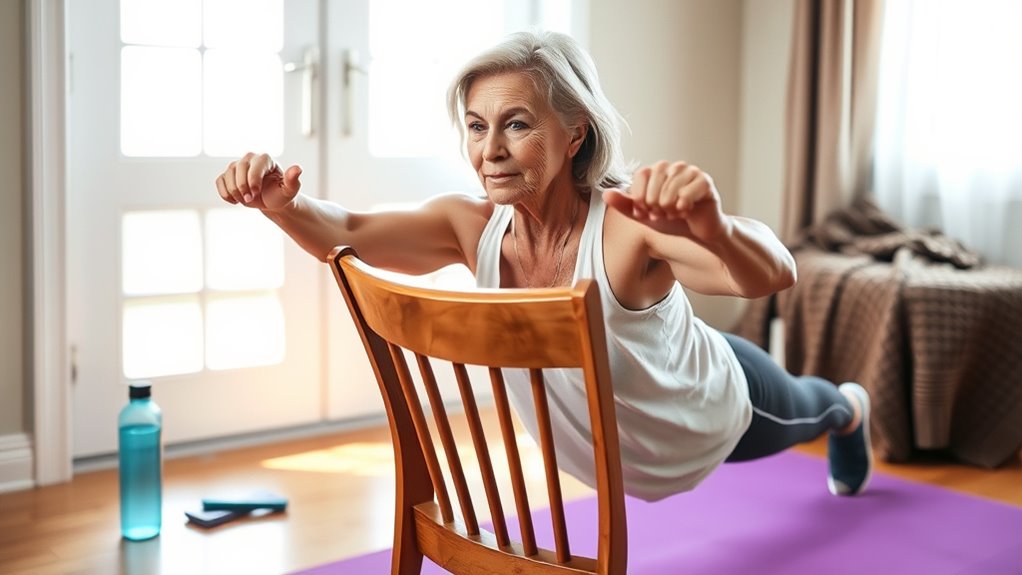
Chair dips are a simple yet effective way to strengthen your triceps, which play a vital role in everyday movements like pushing up from a chair or lifting objects.
To perform chair dips safely, sit on a sturdy chair with arms, grasp the armrests, and lower your body by bending your elbows. Keep your elbows close to your body to maximize effectiveness and minimize injury risk.
Aim for 10 repetitions, maintaining good posture throughout; your back should stay straight and your core engaged for stability.
Incorporating chair dips into your workout a few times a week can enhance your arm strength and overall upper body fitness, making daily tasks easier and more manageable.
Seated Quad Warm-Ups: Preparing Your Legs

To prepare your legs for exercise, seated quad warm-ups are a fantastic way to promote blood flow and enhance flexibility.
Start by sitting on a sturdy chair, and gently extend one leg out straight, holding the position for a few seconds. This stretch targets your quadriceps and improves your range of motion in the knees and hips, which is essential for maintaining mobility as you age.
- Hold each stretch for 15 to 30 seconds
- Repeat on both legs for balanced muscle engagement
- Incorporate these warm-ups into your regular routine to prevent stiffness
Lower Body Strength: Side Leg Raises
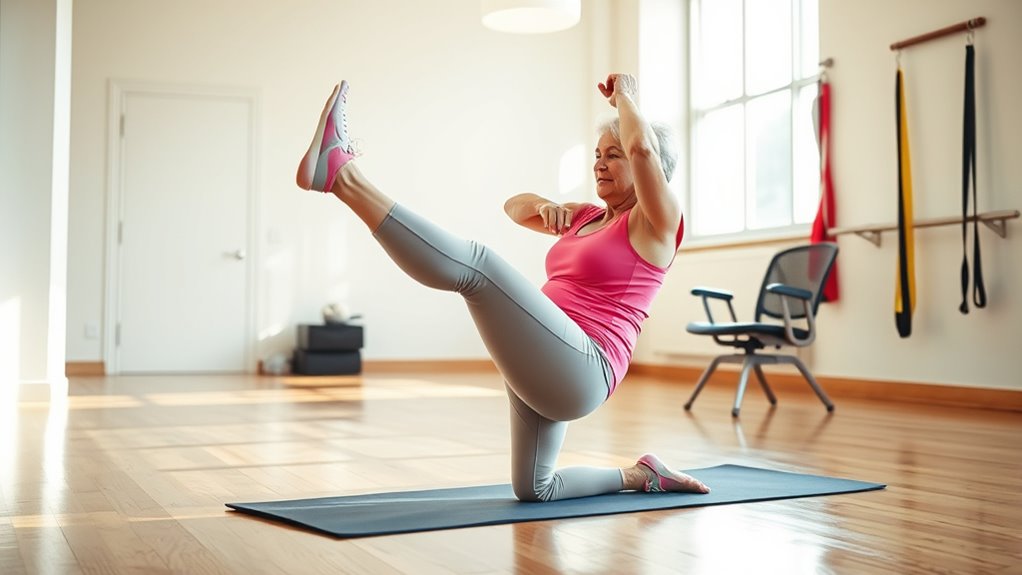
Strengthen your lower body and boost your balance with side leg raises, a simple yet effective exercise for seniors. To perform, stand tall with your feet shoulder-width apart. Lift one leg straight out to the side, keeping your body aligned and avoiding any lean. It’s vital to maintain good posture and engage your core. Aim for 10 repetitions on each side. If you need extra support, grab a sturdy chair. Incorporating side leg raises into your routine can enhance lower body strength, important for preventing falls and improving mobility.
| Step | Action | Repetitions |
|---|---|---|
| 1 | Stand tall | |
| 2 | Lift leg | 10 |
| 3 | Switch sides | 10 |
Back Leg Raises: Targeting Your Glutes

Boost your glute strength and stability with back leg raises, a straightforward exercise that’s perfect for seniors. This move effectively engages your gluteus maximus, essential for overall leg strength and stability.
To perform back leg raises, follow these steps:
- Stand tall with your feet hip-width apart and engage your core.
- Lift one leg straight back while keeping it straight and your posture upright.
- Aim for 10 repetitions on each side, ensuring your shoulders are relaxed and your supporting knee is slightly bent.
Incorporating back leg raises into your routine can greatly improve your balance and coordination.
Consistent practice not only enhances lower body strength but also contributes to better mobility, helping you maintain independence and prevent falls.
Balance Exercises: Staying Steady on Your Feet
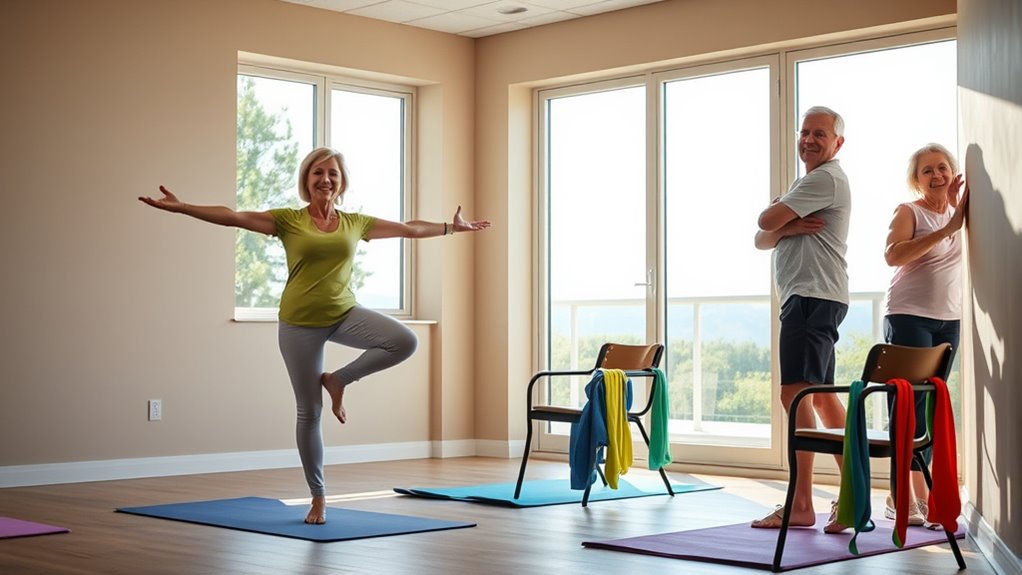
Balance training is essential for staying steady on your feet and preventing falls.
You can easily incorporate simple exercises into your routine to strengthen your stability.
Let’s explore some effective balance exercises and tips to enhance your coordination and overall safety.
Importance of Balance Training
One in four seniors experiences a fall each year, making it essential to prioritize balance training as part of your fitness routine. Falls are a leading cause of injury in older adults, resulting in over 800,000 hospitalizations annually in the U.S.
By engaging in regular balance exercises, you can greatly enhance your stability and coordination, ultimately improving your mobility.
Consider the benefits of balance training:
- Reduces fall risk by 30-50% among older adults.
- Improves overall strength, making daily activities easier.
- Boosts confidence, encouraging you to stay active and socially engaged.
Incorporating balance exercises into your routine not only keeps you steady on your feet but also promotes independence in your daily life.
Simple Balance Exercises
To enhance your stability and prevent falls, incorporating simple balance exercises into your routine is essential. These exercises, like side leg raises and back leg raises, strengthen your hip and core muscles, improving overall balance.
Just a few minutes of balance training each day can greatly boost your coordination and lower your fall risk.
Try shifting your weight from one leg to the other; this helps develop the proprioceptive skills vital for maintaining balance.
Remember, regular practice, along with good posture and core engagement, can increase your confidence in mobility and daily activities.
Start with these simple moves, and you’ll likely notice improvements in your steadiness on your feet in no time!
Tips for Stability
Staying steady on your feet is essential for maintaining independence as you age. To enhance your balance, incorporate these tips into your routine:
- Strengthen hip muscles with side leg raises and back leg raises to improve overall stability.
- Maintain good posture by keeping your shoulders back and head up during exercises to prevent falls.
- Engage your core consistently to stabilize your body, enhancing balance while standing and moving.
Regularly practicing exercises like chair stands and seated quad warm-ups can boost coordination and reduce your fall risk.
Remember to listen to your body and modify exercises as needed to guarantee safety and encourage ongoing participation in balance training.
A steady approach now sets the foundation for a more secure future!
Stretching Techniques for Flexibility

Stretching techniques play an essential role in enhancing flexibility, especially for seniors. After your workouts, hold each stretch for 15 to 30 seconds to effectively improve your flexibility and range of motion over time.
Make it a habit to perform daily stretching routines, focusing on slight tension without pain. For shoulder and triceps stretches, use a towel to maintain proper form, keeping your elbows close to your head for maximum effectiveness.
Incorporate daily stretching routines for improved flexibility, focusing on gentle tension without pain.
Incorporating breathing techniques during stretches can help you relax and improve the overall experience. Don’t forget to balance your stretching; repeat towel stretches on both sides and include ankle and calf stretches to relieve tension in your lower legs.
Your flexibility will thank you!
Cool Down: Importance of Recovery

Cooling down after a workout is just as important as the exercise itself, as it helps your body shift back to a resting state. Skipping this vital step can lead to dizziness or fainting, so take the time to cool down properly.
- Gradually lowers your heart rate, easing your shift back to normalcy.
- Involves stretching, which enhances flexibility and reduces muscle soreness by releasing built-up tension.
- Incorporates breathing techniques that promote relaxation and aid in mental recovery after physical exertion.
Consistent cooldown practices are important for older adults, as they minimize injury risk and enhance muscle repair.
This guarantees you can continue participating in fitness activities with confidence and enjoyment.
Maintaining Good Posture Throughout Your Workout
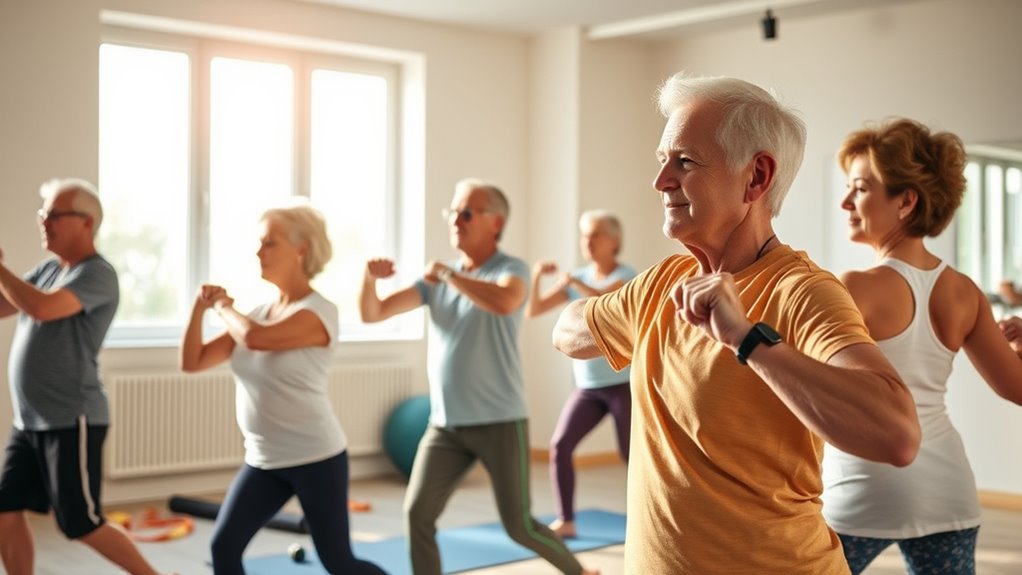
Good posture is essential for getting the most out of your workout, especially as a senior. Keeping your feet shoulder-width apart and engaging your core muscles helps create a stable base.
Be sure to retract your shoulders and elevate your head to prevent strain, enhancing your overall stability. This proper alignment effectively targets muscle groups like your hamstrings and glutes, maximizing the benefits of exercises like chair stands and leg raises.
Avoid slumping or leaning forward to prevent imbalance and reduce injury risk during strength and balance exercises. Consistently remind yourself to draw your abs in tightly to support spinal alignment.
Incorporating posture checks throughout your workout reinforces good habits and boosts your body awareness and confidence in movement.
Tips for Staying Motivated and Consistent
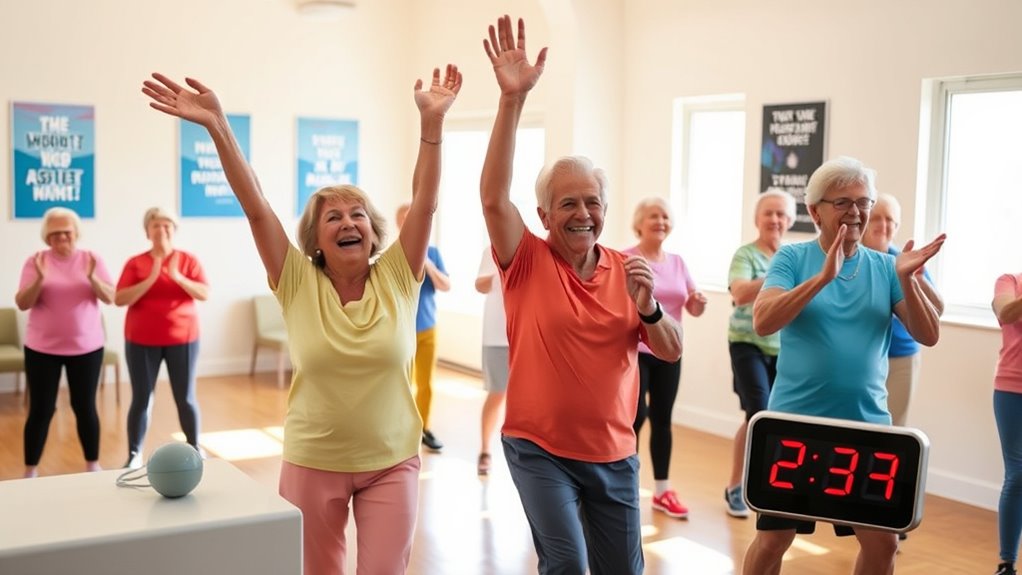
Maintaining good posture not only enhances your workout but also plays a role in keeping you motivated.
Good posture boosts workout performance and fuels motivation, helping you stay focused on your fitness journey.
To stay committed and consistent with your fitness routine, consider these effective tips:
- Set realistic goals: Achievable milestones create a sense of accomplishment and encourage you to keep going.
- Workout with others: Join a class or exercise with friends to boost motivation and make it more enjoyable.
- Track your progress: Keep a workout journal to celebrate milestones and monitor improvements, reinforcing your commitment.
Establish a regular workout schedule by choosing specific days and times, and mix up your exercises to prevent boredom.
Frequently Asked Questions
What Is the Number One Exercise for Seniors?
The number one exercise for you as a senior is often walking. It’s low-impact and easy to fit into your daily routine. Walking helps improve your cardiovascular health and maintain mobility, making it a great choice.
However, don’t forget to incorporate strength training and balance exercises into your routine, too. These activities can enhance muscle mass, stability, and flexibility, ensuring you stay active and healthy as you age.
What Is the Number One Exercise to Increase Balance in Seniors?
Have you ever wondered what the best exercise is for improving balance?
The single-leg stand is often considered the top choice for seniors. It challenges your stability by requiring you to maintain equilibrium on one leg.
Research shows that holding this position for just 10 seconds on each leg can considerably boost your balance and reduce fall risk.
Incorporate it into your routine at least three times a week, and you’ll notice great improvements.
What Is the Most Effective Quick Workout?
The most effective quick workout combines strength, balance, and flexibility exercises.
You can start with arm curls and chair dips to build muscle strength, then incorporate side leg raises and chair stands to enhance your balance.
Finish your session with stretches, holding each for 15 to 30 seconds to improve flexibility.
Even short, consistent workouts can boost your overall health and quality of life, so make it a regular part of your routine!
How Many Minutes a Day Should Seniors Exercise?
You wouldn’t want to binge-watch your favorite show for hours without a break, right?
Similarly, seniors should aim for at least 30 minutes of moderate-intensity exercise most days. That totals about 150 minutes weekly.
You can break it down into shorter sessions—10 to 15 minutes at a time can work wonders!
Just remember to mix in some strength, balance, and flexibility exercises to keep things well-rounded and safe.
Always listen to your body!
Conclusion
In just 15 minutes, you can boost your energy, strengthen your muscles, and enhance your flexibility. Embrace the power of quick workouts to feel stronger and more vibrant. Remember to warm up, focus on your form, and cool down for recovery. Stay motivated by setting small goals and celebrating your progress. With commitment and consistency, you’ll not only improve your fitness but also enrich your daily life. So grab your equipment and get started on this journey to wellness!



